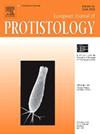Morphology and molecular phylogeny of a new hypotrichous ciliate, Sterkiella zhangi n. sp. (Ciliophora, Oxytrichidae)
IF 1.6
2区 生物学
Q4 MICROBIOLOGY
引用次数: 0
Abstract
The morphology, morphogenesis, and molecular phylogeny of a new hypotrichous ciliate, Sterkiella zhangi n. sp., which originated from terrestrial moss collected in east China, were studied using live observation, protargol staining, and the macronuclear SSU rRNA and mitochondrial cytochrome c oxidase subunit 1 gene sequences. The new species can be distinguished from its congeners by the following characteristics: three ordinary frontal cirri (an extra small frontal cirrus present in half of the individuals examined), an average of 15 left and 16 right marginal cirri, five transverse cirri, two macronuclear nodules, and cyst surface with irregular wrinkles but without spines. The 1:3:3:3:4:4 frontal-ventral-transverse anlagen fragmentation pattern of S. zhangi n. sp. indicates that the extra frontal cirrus is very likely a retained parental structure. Phylogenetic analyses revealed that the new species branches early in the subfamily Stylonychinae. The comparison of mitochondrial cytochrome c oxidase subunit 1 gene sequences of Sterkiella species shows that the intra-specific variation is much smaller than the inter-specific divergence. The well-known model organism Oxytricha trifallax has accumulated significant evolutionary differences and should be treated as a distinct species rather than a synonym of S. histriomuscorum.
一种新的次毛纤毛虫,Sterkiella zhangi n. sp.(纤毛虫目,毛虱科)的形态和分子系统发育
采用活体观察、原甲酚染色、大核SSU rRNA和线粒体细胞色素c氧化酶亚单位1基因序列等方法,研究了产于中国东部陆生苔藓中的下富集纤毛虫新种Sterkiella zhangi n. sp.的形态、形态发生和分子系统发育。该新品种可通过以下特征与其同类区分开来:3 个普通额圈(半数个体有一个额外的小额圈)、平均 15 个左侧和 16 个右侧边缘圈、5 个横向圈、2 个巨核结节、囊肿表面有不规则皱纹但无棘刺。张氏囊藻 1:3:3:3:4:4 的额面-腹面-横面原基分裂模式表明,额外的额面卷须很可能是保留下来的亲本结构。系统进化分析表明,该新种在石龙子亚科中分支较早。通过比较 Sterkiella 的线粒体细胞色素 c 氧化酶亚单位 1 基因序列发现,种内变异远远小于种间差异。众所周知的模式生物 Oxytricha trifallax 在进化过程中积累了显著的差异,应将其作为一个独立的物种而不是 S. histriomuscorum 的异名。
本文章由计算机程序翻译,如有差异,请以英文原文为准。
求助全文
约1分钟内获得全文
求助全文
来源期刊

European journal of protistology
生物-微生物学
CiteScore
4.60
自引率
20.70%
发文量
55
审稿时长
14.6 weeks
期刊介绍:
Articles deal with protists, unicellular organisms encountered free-living in various habitats or as parasites or used in basic research or applications. The European Journal of Protistology covers topics such as the structure and systematics of protists, their development, ecology, molecular biology and physiology. Beside publishing original articles the journal offers a forum for announcing scientific meetings. Reviews of recently published books are included as well. With its diversity of topics, the European Journal of Protistology is an essential source of information for every active protistologist and for biologists of various fields.
 求助内容:
求助内容: 应助结果提醒方式:
应助结果提醒方式:


